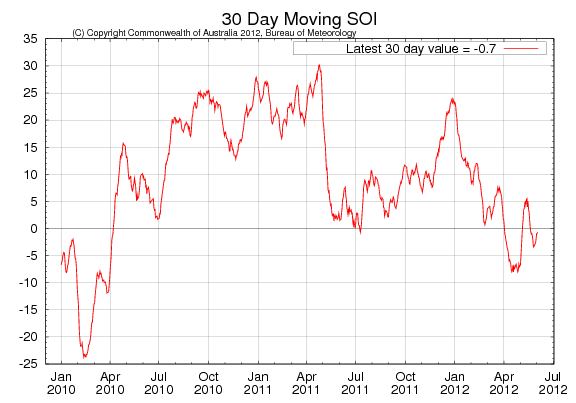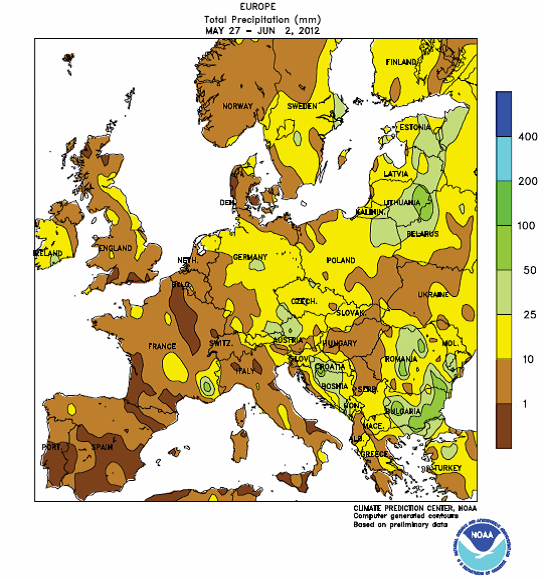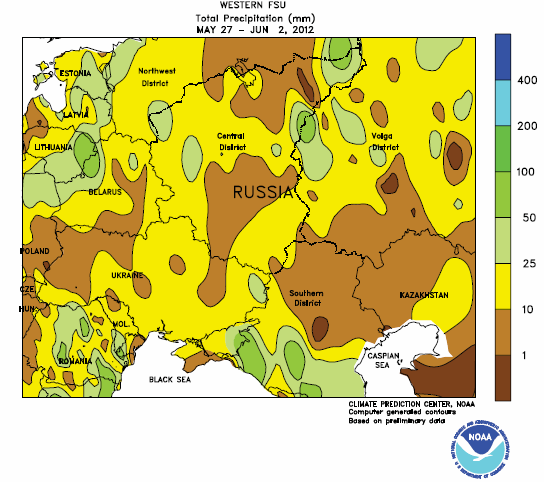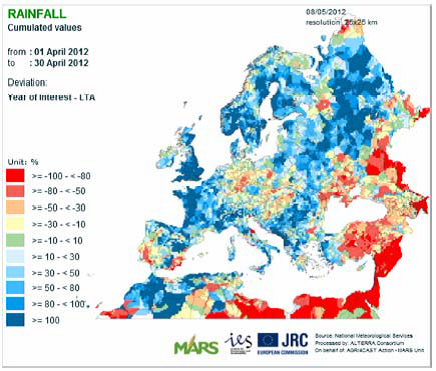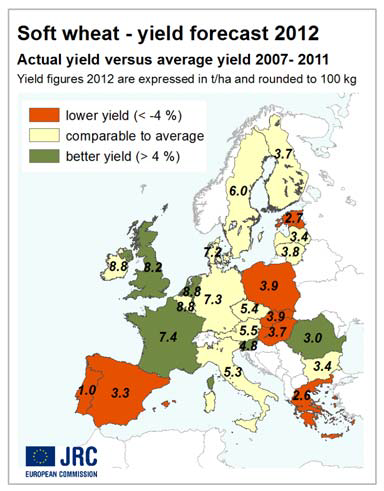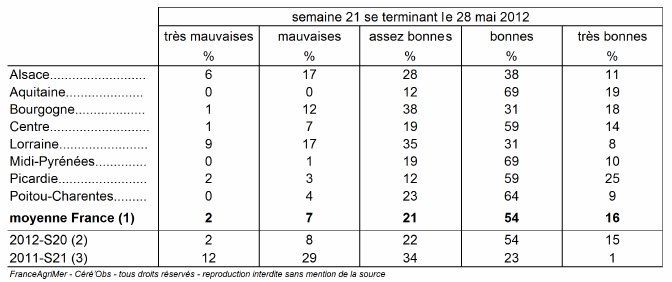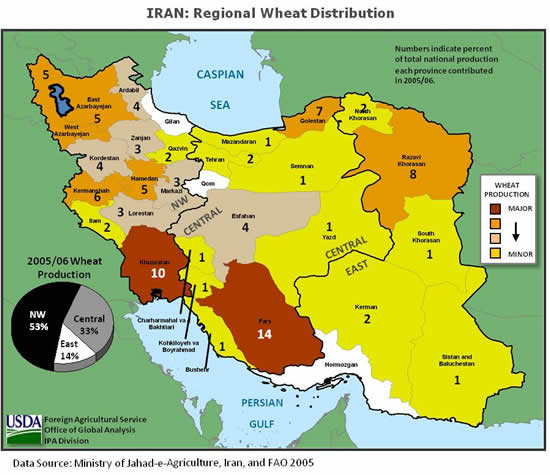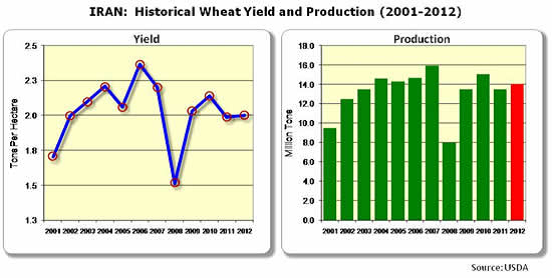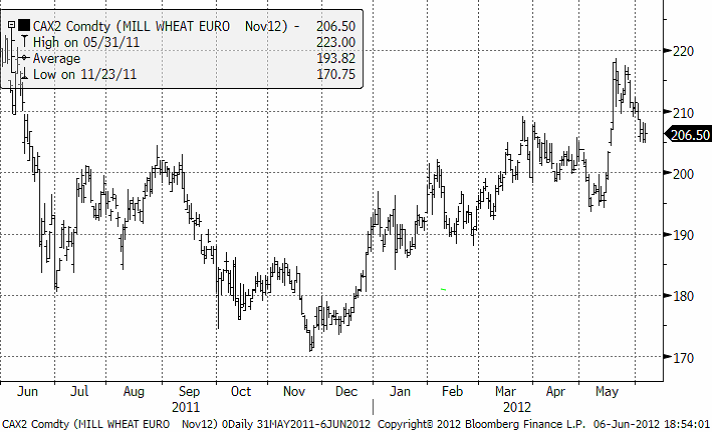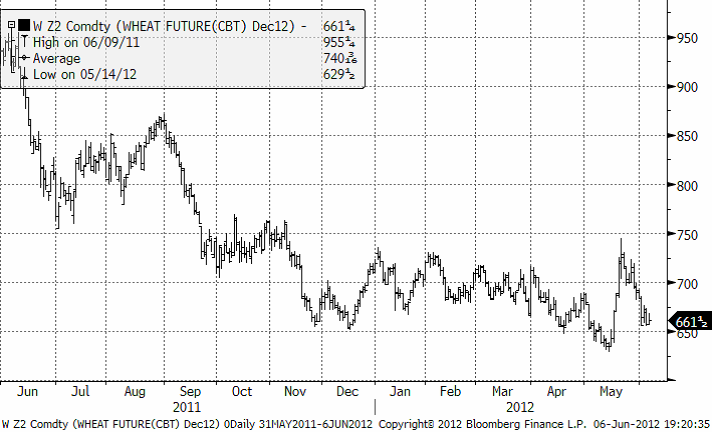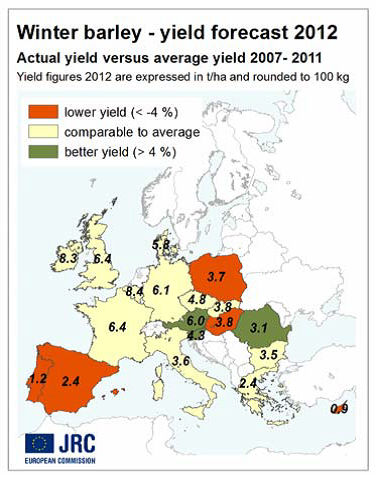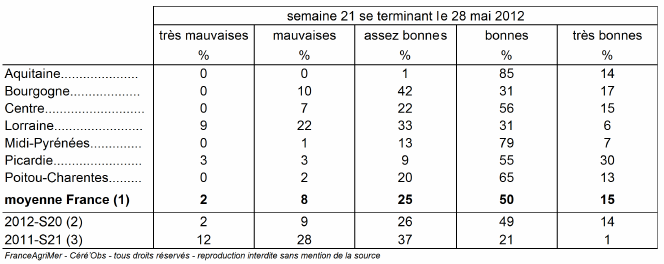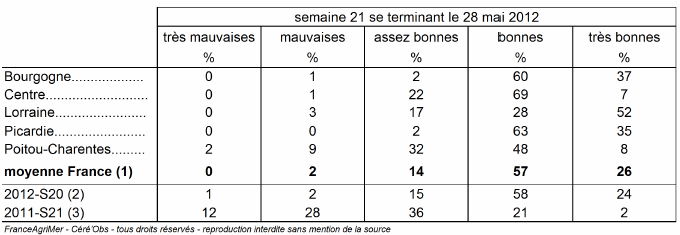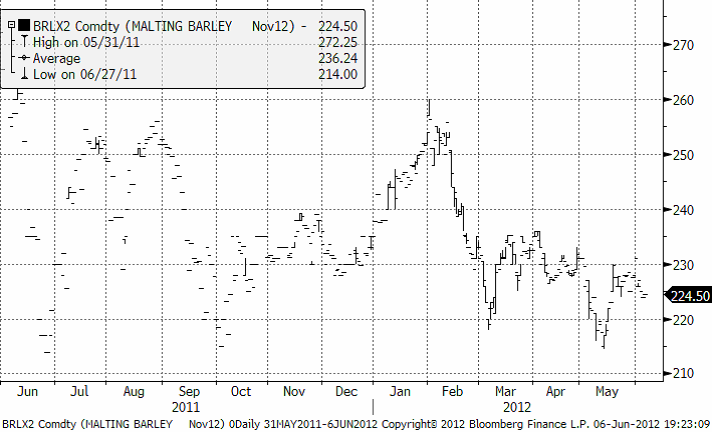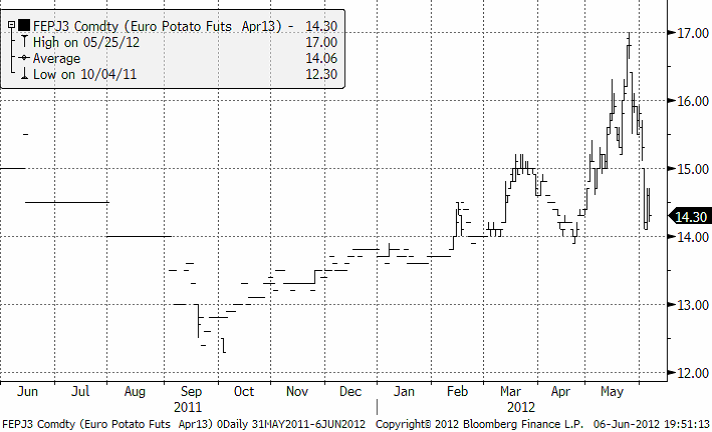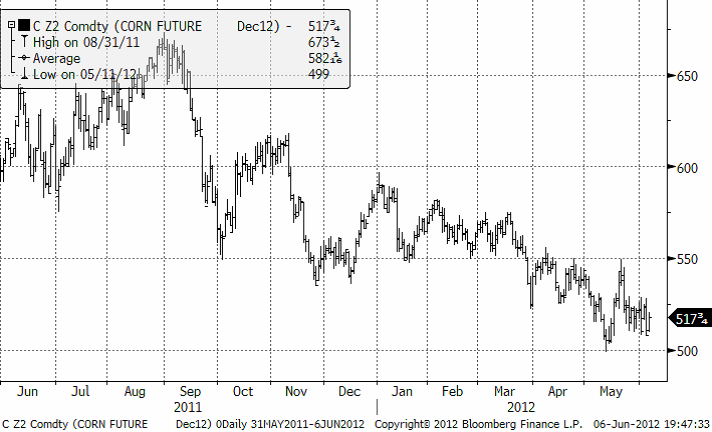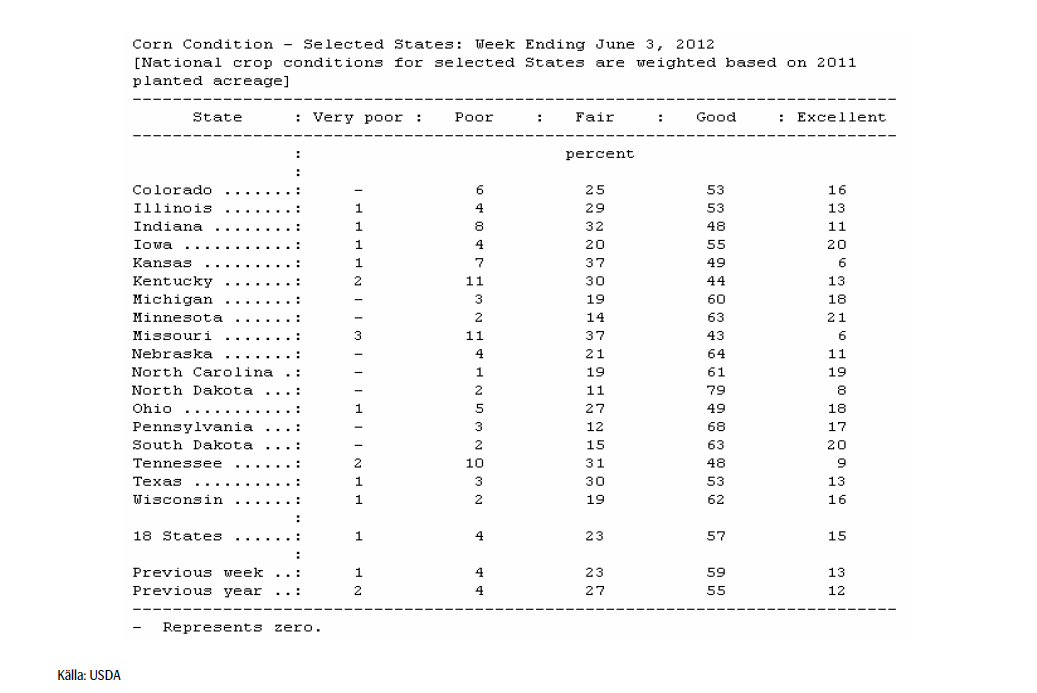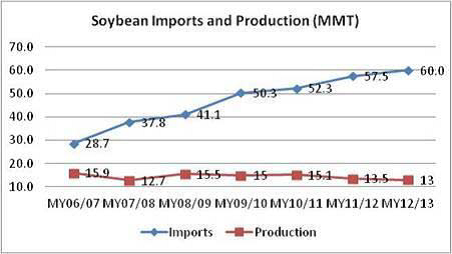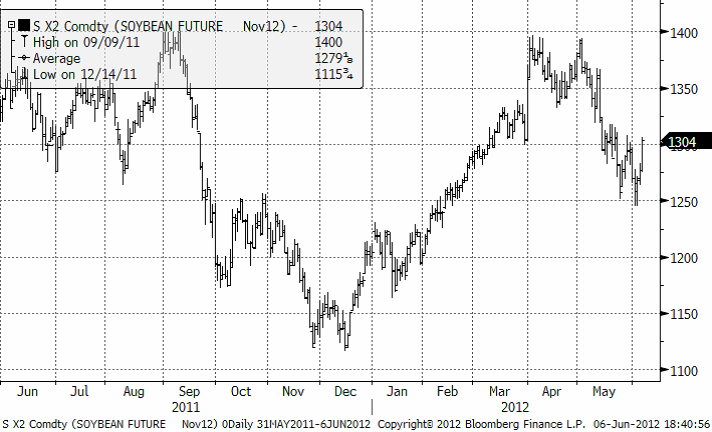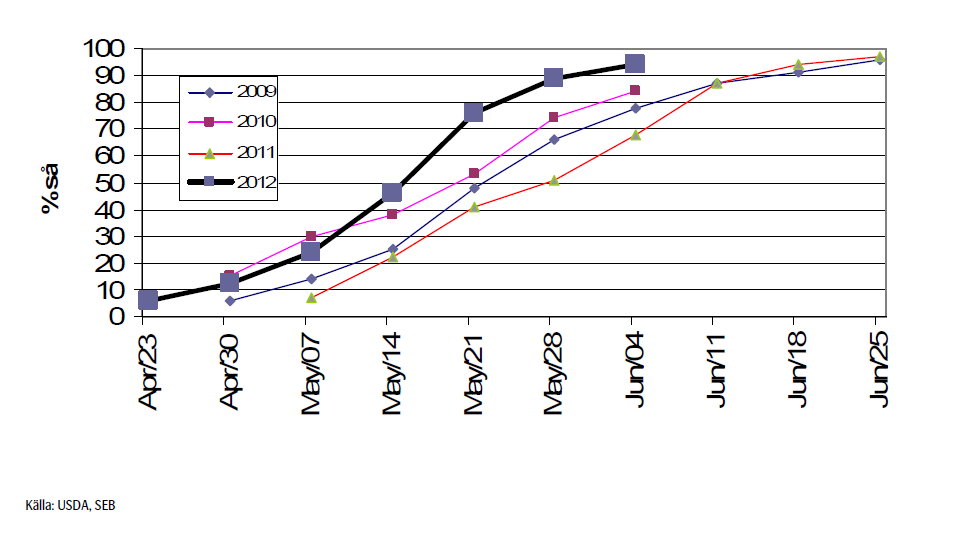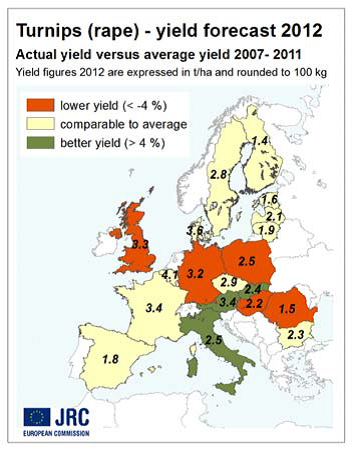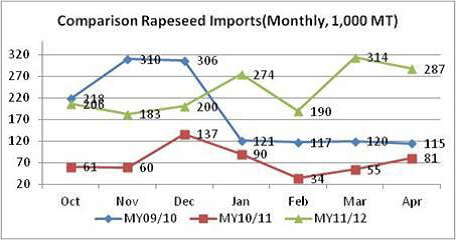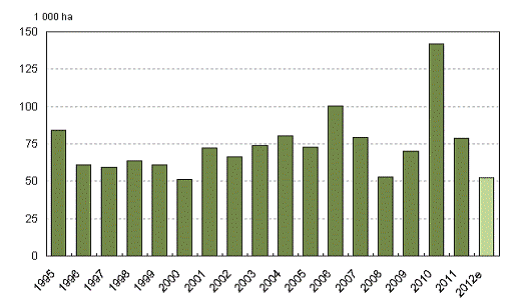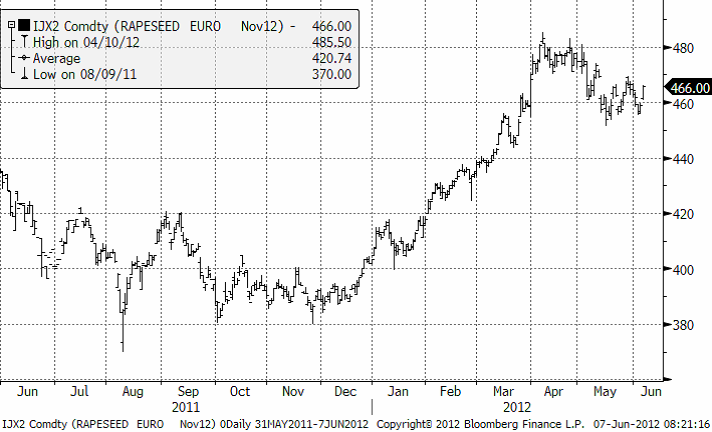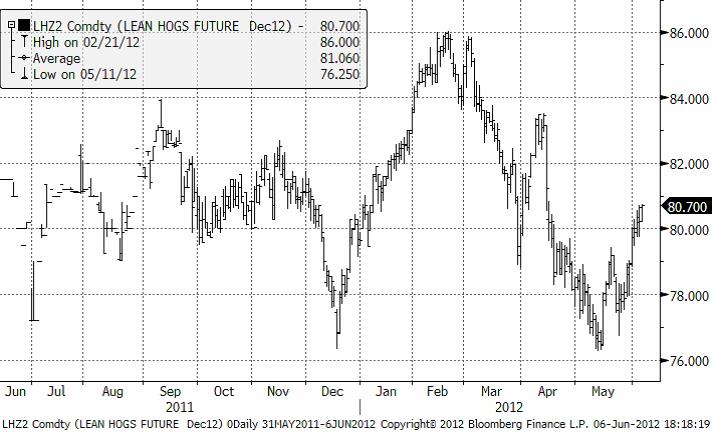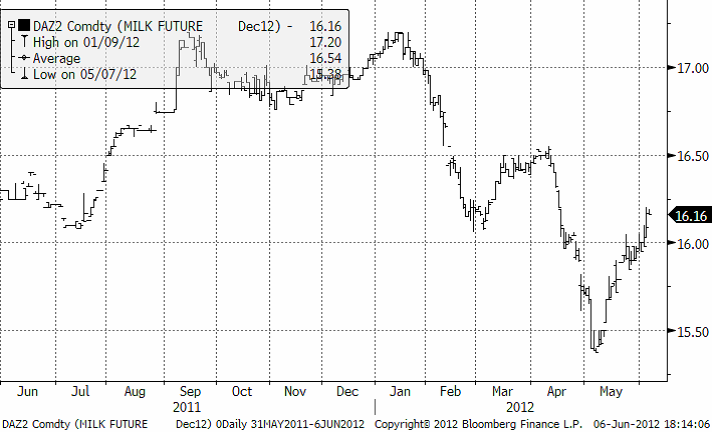Analys
SEB – Jordbruksprodukter, vecka 23 2012

 Svag makrostatistik i USA (81k färre jobb än väntat och sämre industrisentiment) tillsammans med fortsatt skuldoro i Europa och allt fler tecken på en konjunkturavmattning i Kina har tyngt börserna.
Svag makrostatistik i USA (81k färre jobb än väntat och sämre industrisentiment) tillsammans med fortsatt skuldoro i Europa och allt fler tecken på en konjunkturavmattning i Kina har tyngt börserna.
Tillväxtoron satte också sin prägel på råvaror och oljepriset föll nästan 10% under förra veckan. Guldet fortsätter däremot att stiga då många söker sig till säkra och likvida tillgångar. Gårdagens viktigaste hållpunkt var ECB och det räntebesked som landade (icke överraskande) i oförändrad styrränta på 1% och Bernankes tal idag kommer att bli viktigt för hur aktier och räntor utvecklas framöver.
På tisdag, den 12 juni, kommer USDA´s WASDE rapport, och för första gången så kommer CBOT att vara öppen vid tidpunkten då rapporten släpps.
Igår var första handelsdagen för CME’s futureskontrakt på Black Sea Wheat, och vi noterar att Sep12 kontraktet, som var det enda kontraktet som det handlades i under dagen, stängde på 254.50 usd/t.
Odlingsväder
Southern Oscillation Index, ett mått på intensiteten i graden av La Niña eller El Niño, håller sig på den negativa sidan av neutral och ligger nu på -0.7. Ett värde mellan +8 och -8 indikerar neutrala ENSOförhållanden.
Kontrasterna i Europa under förra veckan har varit stora med varmt torrt väder i de västra delarna och kallt och regnigt i öster. I Frankrike och England har den senaste tidens regn främjat höstgrödornas utveckling, men också gett upphov till ökad risk för sjukdomar. Även Tyskland, Polen och norra Balkan har fått välbehövligt regn (10-35 mm) medan det torra och varma vädret i Italien och Spanien har gynnat höstkorn och skörden av vete.
Andra vecka i rad med måttliga till kraftiga regnskurar i stora delar av Svarta Havsregionen har gynnat grödorna där, och förbättrat utsikterna i de veteproducerande områdena i södra Ukraina och de södra delarna av Rysslands södra distrikt.
Vete
Den Europeiska kommissionens analysenhet MARS kom med sin senaste rapport i förra veckan och skriver där att april månad präglades av en hel del regn i västra och norra Europa medan torrperioden fortsatte i södra Ukraina, och mer regn var behövligt i delar av Tyskland, Polen, Slovakien och Ungern. Temperaturer under det normala har noterats i Storbritannien, Irland, norra Europa och västra Frankrike, medan höga temperaturer har registrerats bl.a. över den Iberiska halvön och runt Svarta Havet. Kommissionens nuvarande utsikter för EU-27’s grödor ligger runt genomsnittet.
Prognosen för vete produktionen inom EU-27 har reviderats ned med 200 000 ton sedan förra rapporten till 126.5 mt, främst på grund av lägre förväntad avkastning i Tyskland, Bulgarien och Rumänien. Dock har avkastningsprognosen för Frankrike och Storbritannien justerats upp något och den genomsnittliga avkastningen för dessa länder beräknas uppgå till 7.19 ton per hektar respektive 8.18 ton per hektar.
Enligt preliminära uppgifter från Tike ökar spannmålsarealen i Finland med sammanlagt 6 procent och uppgår nu till ca 1 170 000 hektar. I år förväntas vetearealen att uppgå till 245 00 hektar vilket är 5 procent mindre än förra året och beror på att höstvetearealen minskar från nästan 40 000 till 24 000 hektar (-39%). Vårvetearealen kommer att öka med ca 1 procent till 220 000 hektar.
De tyska lantbrukarna har återigen fått uppleva en mycket torr vår, efter förra årets vår med extremt låg nederbörd. Tysklands spannmålsskörd förväntas i detta skede att hamna under landets genomsnittliga årliga produktion på ca 45 mt, enligt DBV (Deutsche Bauernverband) men rikliga regn under de kommande dagarna och veckorna kan fortfarande bidra till en positiv utveckling.
Tillståndet för det franska vetet har fortsatt att förbättras och andelen vete klassat som ”bra” (bonnes) eller ”utmärkt” (très bonnes) har ökat till 70% från 69% veckan innan enligt FranceAgriMer. Siffrorna visar på en fortsatt återhämtning från början av april, då torkan nu har lindrats av den senaste tidens regn, och siffran ligger väl över de 24% vid samma tid förra året när franska grödor skadades av en långvarig torka.
Det franska durumvetet klassat som ”bra eller ”utmärkt” har ökat till 60% från 57 procent veckan innan.
Crop condition för höstvetet i USA, som rapporterades i måndags kväll ligger nu på 52% good / excellent och det är 2% lägre än förra veckan.
Skörden av höstvete i USA går fort fram. Oklahoma skördade 30% förra veckan vilket gör att den avklarade skörden där nu uppgår till 73% – en bra bit över genomsnittet på 13%. Kansas har klarat av 16% av sin skörd under förra veckan och därmed uppgår den avklarade skörden där till 20% – vanligtvis är den ännu inte påbörjad.
Egypten, världens största importör av vete, har lagt till Polen som en potentiell leverantör av grödan och det polska vetet håller samma kvalitet som det tyska vetet enligt GASC. Egypten konsumerar ca 14 mt vete per år och importen står för ungefär hälften. Sedan början på säsongen 2011/12 har importen dominerats av vete med ursprung från Svarta Havsregionen med bla 3.24 mt från Ryssland och 360 000 ton från Ukraina.
Utsikterna för 2012 års höstvete i Marocko, som snart ska skördas, ser dåliga ut. Kraftig nederbörd försenade sådden i november till december och januari, och därefter sjönk regnmängderna snabbt till minimala nivåer från december till början av mars. Låga temperaturer i början och mitten av februari påverkade också grödorna. Trots nederbörd i april har mycket av avkastningspotentialen redan gått förlorad, särskilt för vete. Som ett resultat av detta beräknas produktionen av vete att uppgå till 2.7 mt, en kraftig minskning med ca 55% jämfört med förra året.
Irans ekonomi har varit under betydande press under de senaste två åren på grund av samordnade internationella sanktioner mot landets oljeindustri och banker, en stor devalvering av valutan och borttagna påtagliga subventioner av bränsle, bröd, ris, vegetabiliska oljor och socker som en följd av regeringens ekonomiska reformer. Resultatet har blivit en dramatisk ökning av den inhemska inflationen och flaskhalsar i handeln, och även om de nuvarande sanktionerna inte inkluderar mat eller jordbruksråvaror så har sanktionerna mot iranska banker och handelsföretag hindrat landets förmåga att finansiera nödvändig import. CBI (Central Bank of Iran) rapporterar att de genomsnittliga livsmedelspriserna steg 40-156 procent under de senaste 12 månaderna och mot bakgrund av detta får utsikterna för landets veteproduktion 2012 större betydelse. Vete tillhör basfödan och bröd är den viktigaste dagliga livsmedelsprodukten. Baserat på statistik från den Iranska regeringen konsumerar en person i genomsnitt ca 8.7 kg bröd per månad.
Dessvärre är utsikterna för landets veteproduktion 2012 något nedslående. Generellt sett så har Iran haft en måttligt positiv växtsäsong i år, men de regionala förhållandena har varit ganska varierande. Veteproduktionen beräknas bli marginellt högre än förra året, men en fördubbling av importen förväntas för att möta den inhemska efterfrågan och för att bygga upp tömda lager. USDA’s uppskattning av produktionen per den 10 maj 2012 ligger på 14 mt, en ökning med 4 procent från förra året. Avkastningen beräknas till 2,0 ton per hektar, vilket är något över det 5-åriga genomsnittet.
Ukrainian Grain Association uppskattar ingående lager per den 1 juli 2012 i nivå med över 12 mt, och ordföranden Vladimir Klimenko sa också i samband med detta att man efter nuvarande säsong (juli 2011 – juni 2012) inte kommer att stoppa landets export av spannmål, såsom inträffade förra året. Exporten under 2011/12 beräknas uppgå till 22 mt, då Ukraina räknar med att exportera nästan 2 mt spannmål under juni.
2011 producerade Ukraina 56.7 mt spannmål, en ökning med 44.3% jämfört med 2010. Den inhemska konsumtionen beräknas ligga på 26.7 mt per år. Matifvetet med novemberleverans föll tillbaka i fredags och bröt igenom stöd nivån på 210 eur. Förbättrade väderutsikter i Europa och Svartahavsområdet tillsammans med svag makrostatistik som tyngde börserna och råvaror drog också med sig priset på kvarnvetet som sedan dess har pendlat mellan stödnivån 205 eur och 208 eur.
Nedan ser vi Chicagovetet med leverans i december .
Maltkorn
Enligt den Europeiska kommissionens analysenhet MARS senaste rapport förväntas produktionen av korn inom EU-27 att öka till 55.4 mt från tidigare 51.3 mt.
Prognosen för höstkorn justeras ned med 2.7% jämfört med föregående prognos, främst på grund av en förväntad minskad avkastning i Tyskland och Frankrike. Estimatet för vårkorn justeras däremot upp med 5% då avkastningsprognosen för Spanien har ökat med 11%. Köldknäppen i februari har orsakat betydande skador på höstgrödorna i östra Frankrike, Tyskland, Polen och vissa områden i Rumänien och Bulgarien och därmed bortfall i areal. Som en följd av detta gynnas vårgrödor och arealen för vårgrödor revideras istället upp. I Frankrike kommer skadade höstgrödor främst att ersättas med vårkorn, och i Tyskland och Polen med vårkorn och majs.
Enligt FranceAgriMer har andelen franskt höstkorn klassat som ”bra” (bonnes) eller ”utmärkt” (très bonnes) ökat till 65% från 63% veckan innan, baserat på förhållanden i sju regioner som representerar 56 procent av landets produktion.
Vad gäller franskt vårkorn ökade klassificeringen ”utmärkt” till 26 procent från 24 procent veckan innan, medan grödorna som klassificeras som ”bra” sjönk med 1 procent till 57 procent. Siffrorna baseras på data från fem regioner som i genomsnitt odlar 47 procent av landets vårkorn.
De senaste två åren har korn arealen i Finland varit exceptionellt liten. Korn är Finlands vanligaste spannmål och det odlas på 505 000 hektar, av vilket största delen (ca 80%) utgörs av foderkorn. Trots en ökning med ca 9% jämfört med 2011, enligt Tikes preliminära uppgifter, är odlingsarealen för korn ändå klart mindre jämfört med t.ex 2008 och 2009.
Liksom kvarnvetet föll priset på novemberkontraktet på maltkorn i fredags kväll och handlas nu på 224.50 eur.
Potatis
Potatispriset för leverans nästa år, har fortsatt att falla och bröt i fredags igenom 15 eur nivån.
Majs
Priset på decembermajs har fått support under veckan av oro över det torra vädret i USA samt obekräftade uppgifter om inköp av majs av Kina. En förväntad rekordproduktion i Brasilien och fortsatt goda Crop conditions för majs i USA fick dock priset att falla tillbaka under tisdagen för att sedan återhämta sig något igen.
Trots förra veckans varma och torra väder i USA som orsakade oro och fick marknaden att förvänta sig en nedgång i crop condition för majs, så visar måndagens rapport från USDA inga förändringar utan good/excellent kvarstår på 72%.
Trots torka så har Conab justerat upp sin prognos för Brasiliens majsproduktion till rekordhöga 67.79 mt, jämfört med 65.9 mt för en månad sedan. Stämmer siffrorna så kommer det att vara första gången på över 10 år som Brasilien skördar mer majs än sojabönor.
Sojabönor
Produktionen av sojabönor 2012/13 i Kina beräknas uppgå till 13 mt, en minskning från förra årets estimat på 13.5 mt. Förhållandevis liten intjäning på sojabönor i de stora produktionsområdena fortsätter att påverka lantbrukare att byta mot alternativa grödor med högre intjäning, som majs och ris, en trend som förväntas fortsätta. Enligt China’s National Grain and Oils Information Center (CNGOIC) rapport i maj, förväntas den odlade arealen för sojabönor att sjunka till 7.15 miljoner hektar från föregående års 7.65 miljoner hektar. Importen av sojabönor 2011/12 beräknas till 57 mt, upp från tidigare estimat om 55.8 mt.
Sojabönsimporten under de senaste sex åren visar på en stadig ökning varje år medan den inhemska produktionen av sojabönor visar på en fallande trend. Nuvarande estimat över en minskad produktion i år ger stöd till en importprognos på 60 mt för 2012/13. Tillväxten i Kinas foderproduktion är en viktig faktor som driver importen av sojabönor och den ökande omfattningen av svin- och fjäderfä produktion i landet driver konsumtionen och produktionen av foder.
Efter att skörden av sojabönor nu är klar i Brasilien så reviderar Conab ner sin prognos ytterligare till 66.34 mt mot tidigare 66.68 mt och mot förra årets rekordskörd på 75.3 mt. Ingående lager förväntas sjunka till 1 mt, de lägsta sedan 2008/09 och en nedgång med omkring 65 procent från förra året. Ingen större revidering av grödan förväntas under de kommande månaderna.
Brasilianska bönder har sålt 87% av skörden redan. Samma tid förra året var det 68%. De har även sålt 28% av 2013 års skörd.
Priset på sojabönor föll tillbaka i slutet på förra veckan till följd av sämre än väntade exportsiffror och fallande priser i råolja, men vände sedan återigen uppåt i början av denna vecka , dels efter en bekräftad försäljning av sojabönor till Kina samt att USDA’s rapport i måndags visade en något sämre crop condition för sojabönor än väntat (65% good/excellent mot 70% förväntat).
Sådden går fort framåt i USA är nu avklarad till 94% jämfört med förra veckans 89%. I södra USA har man skördat klart höstvetet och kan så en andra skörd av sojabönor.
Raps
Europeiska Kommissionens MARS enhet skriver i sin senaste rapport att endast marginella förändringar förväntas i produktionen av raps i EU-27, som därmed beräknas uppgå till 19.2 mt (jämfört med 19.3 mt föregående år). Nedjusteringen i avkastningen för Tysklands sedan förra rapporten kompenseras av en ökad avkastning i Frankrike.
CNGOIC estimerar att arealen för raps i Kina 2012/13 kommer att minska med 2 procent till 7.05 miljoner hektar och att produktionen kommer att minska till 12.8 mt från föregående års 13 mt. Precis som i fallet med sojabönor, så skiftar lantbrukare odling av raps mot mer lönsamma grödor som vete och grönsaker.
Avkastningen under 2012/13 förväntas dock bli högre än föregående år på grund av gynnsamma väderförhållanden.
Importen av raps 2012/13 beräknas uppgå till 2.1 mt, en uppgång från estimatet 2 mt under 2011/12, till följd av en fortsatt inhemsk efterfrågan tillsammans med ett borttagande av importrestriktioner.
I början av 2012 godkändes 18 nya crushing plants, huvudsakligen belägna i regioner utan egen produktion och som istället kommer att nyttja importerad raps, något som har ökat Kinas handel med oljeväxten från Kanada och Australien.
Futures kontrakt på rapsfrö och rapsmjöl kommer snart att listas på börsen Zhengzhou Commodity Exchange, där rapsolja redan handlas.
Enligt Tike har rybsarealen i Finland varierat mycket de senaste åren. 2010 slogs ett nytt rekord med ca 142 000 hektar, men året därpå uppgick arealen endast till drygt 77 000 hektar och tillbakagången verkar fortsätta även i år. Rybsarealen beräknas uppgå till 52 000 hektar, vilket är över 60 procent mindre jämfört med 2010.
Rybs arealen 1995 – 2012e
Om vi tittar tillbaka på priset på novemberterminen i förra veckans ags letter så låg det på 464.75 eur och det är ungefär där vi befinner oss nu också. Däremellan har vi dock fått se priset rasa ned till 456 eur vid öppningen i måndags, pressat av finansiell oro och fallande råoljepriser, för att sedan återhämta sig och stiga 7 eur under gårdagen.
Gris
Priset på decemberkontraktet har rört sig uppåt sedan förra veckan och handlas nu över 80.50 cent.
Mjölk
Decemberkontraktet för mjölk har nu brutit igenom motståndet på 16 cent.
[box]SEB Veckobrev Jordbruksprodukter är producerat av SEB Merchant Banking och publiceras i samarbete och med tillstånd på Råvarumarknaden.se[/box]
Disclaimer
The information in this document has been compiled by SEB Merchant Banking, a division within Skandinaviska Enskilda Banken AB (publ) (“SEB”).
Opinions contained in this report represent the bank’s present opinion only and are subject to change without notice. All information contained in this report has been compiled in good faith from sources believed to be reliable. However, no representation or warranty, expressed or implied, is made with respect to the completeness or accuracy of its contents and the information is not to be relied upon as authoritative. Anyone considering taking actions based upon the content of this document is urged to base his or her investment decisions upon such investigations as he or she deems necessary. This document is being provided as information only, and no specific actions are being solicited as a result of it; to the extent permitted by law, no liability whatsoever is accepted for any direct or consequential loss arising from use of this document or its contents.
About SEB
SEB is a public company incorporated in Stockholm, Sweden, with limited liability. It is a participant at major Nordic and other European Regulated Markets and Multilateral Trading Facilities (as well as some non-European equivalent markets) for trading in financial instruments, such as markets operated by NASDAQ OMX, NYSE Euronext, London Stock Exchange, Deutsche Börse, Swiss Exchanges, Turquoise and Chi-X. SEB is authorized and regulated by Finansinspektionen in Sweden; it is authorized and subject to limited regulation by the Financial Services Authority for the conduct of designated investment business in the UK, and is subject to the provisions of relevant regulators in all other jurisdictions where SEB conducts operations. SEB Merchant Banking. All rights reserved.
Analys
Brent crude inching higher on optimism that US inflationary pressures are fading


Brent crude price inching higher on optimistic that US inflationary pressures are fading. Brent crude closed up 1.1 USD/b ydy to a close of USD 86.39/b which was the highest close since the end of April. This morning it is trading up another half percent to USD 86.9/b along with comparable gains in industrial metals and Asian equities. At 14:30 CET the US will publish its preferred inflation gauge, the PCE figure. Recent data showed softer US personal spending in Q1. Expectations are now high that the PCE inflation number for May will show fading inflationary pressures in the US economy thus lifting the probability for rate cuts later this year which of course is positive for the economy and markets in general and thus positive for oil demand and oil prices. Hopes are high for sure.
Brent crude is trading at the highest since the end of April
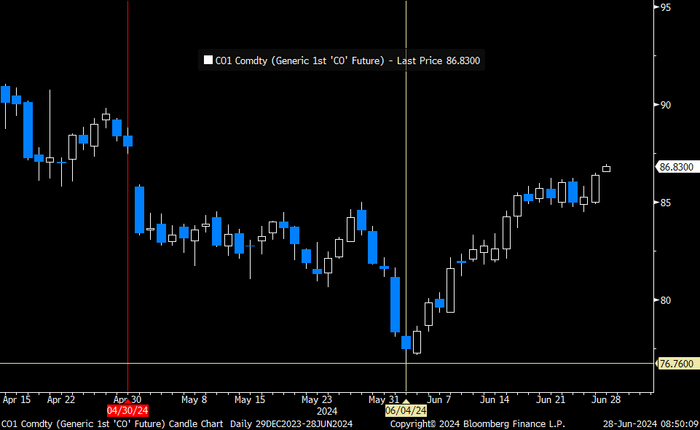
The rally in Brent crude since early June is counter to rising US oil inventories and as such a bit puzzling to the market.
US commercial crude and oil product stocks excluding SPR.
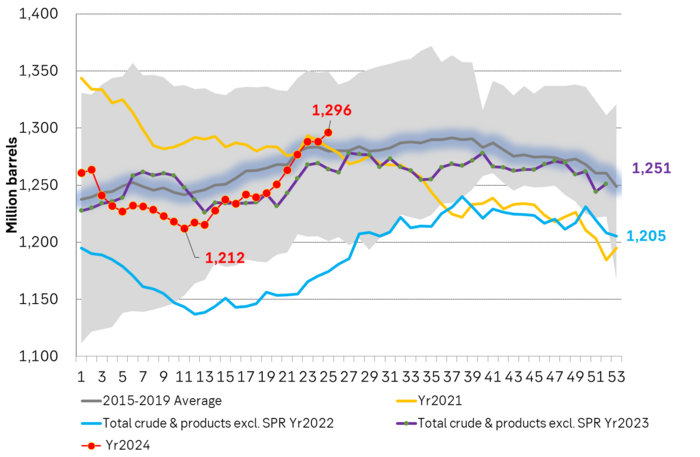
Actual US crude oil production data for April will be published later today. Zero growth in April is likely. Later today the US EIA will publish actual production data for US crude and liquids production for April. Estimates based on US DPR and DUC data indicates that there will indeed be zero growth in US crude oil production MoM in April. This will likely driving home the message that there is no growth in US crude oil production despite a Brent crude oil price of USD 83/b over the past 12 mths. The extension of this is of course rising expectations that there will be no growth in US crude oil production for the coming 12 months either as long as Brent crude hoovers around USD 85/b.
US production breaking a pattern since Jan 2014. No growth at USD 83/b. What stands out when graphing crude oil prices versus growth/decline in US crude oil production is that since January 2014 we have not seen a single month that US crude oil production is steady state or declining when the Brent crude oil price has been averaging USD 70.5/b or higher.
US Senate looking into the possibility that US shale oil producers are now colluding by holding back on investments, thus helping to keep prices leveled around USD 85/b.
Brent crude 12mth rolling average price vs 4mth/4mth change in US crude oil production. Scatter plot of data starting Jan 2014. Large red dot is if there is no change in US crude oil production from March to April. Orange dots are data since Jan 2023. The dot with ”-1.3%” is the March data point.
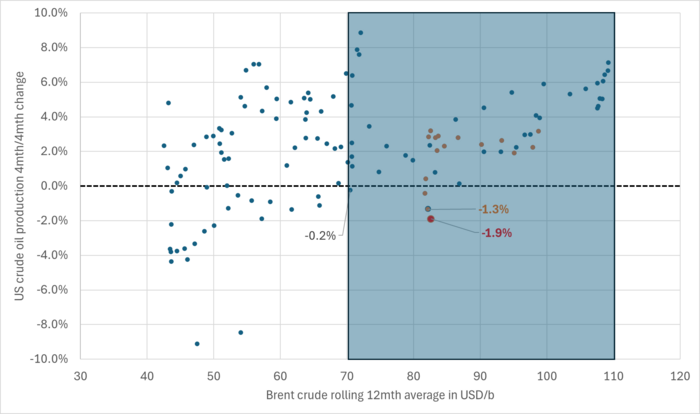
Brent crude 12mth rolling average price vs 4mth/4mth change in US crude oil production. Data starting Jan 2014. The last data point is if there is no change in US crude oil production from March to April.
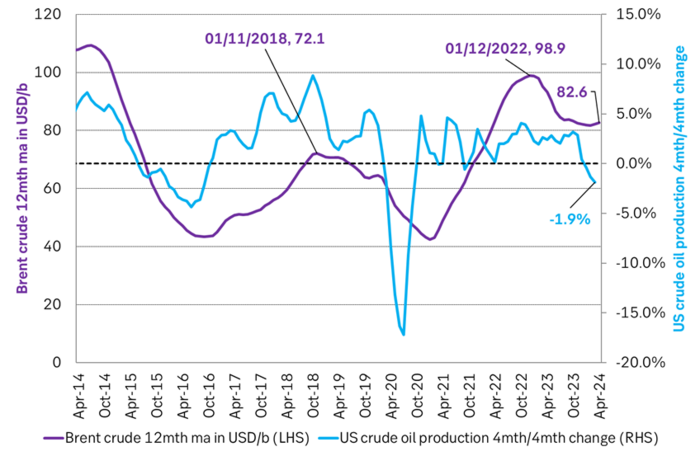
Analys
Price forecast update: Weaker green forces in the EU Parliament implies softer EUA prices


We reduce our forecast for EUA prices to 2030 by 10% to reflect the weakened green political agenda in the EU Parliament following the election for the Parliament on 6-9 June. The upcoming election in France on 7 July is an additional risk to the political stability of EU and thus in part also to the solidity of the blocks green agenda. Environmental targets for 2035 and 2040 are most at risk of being weakened on the margin. EUA prices for the coming years to 2030 relate to post-2030 EUA prices through the bankability mechanism. Lower post-2030 climate ambitions and lower post-2030 EUA prices thus have a bearish impact on EUA prices running up to 2030. Actual softening of post-2030 climate ambitions by the EU Parliament have yet to materialize. But when/if they do, a more specific analysis for the consequences for prices can be carried out.
EUA prices broke with its relationship with nat gas prices following the EU Parliament election. The EUA price has dutifully followed the TTF nat gas price higher since they both bottomed out on 23 Feb this year. The EUA front-month price bottomed out with a closing price of EUR 50.63/ton on 23 Feb. It then reached a recent peak of EUR 74.66/ton on 21 May as nat gas prices spiked. Strong relationship between EUA prices and nat gas prices all the way. Then came the EU Parliament election on 6-9 June. Since then the EUA price and TTF nat gas prices have started to depart. Bullish nat gas prices are no longer a simple predictor for bullish EUA prices.
The front-month EUA price vs the front-year TTF nat gas price. Hand in hand until the latest EU Parliament election. Then departing.
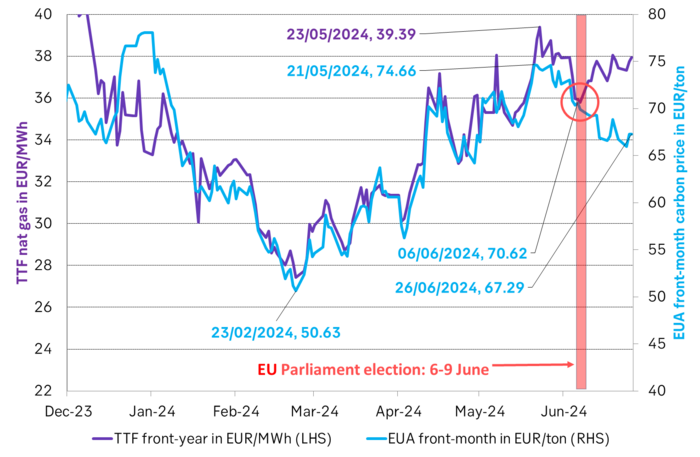
The EU Parliament election on 6-9 June was a big backlash for the Greens. The Greens experienced an euphoric victory in the 2019 election when they moved from 52 seats to 74 seats in the Parliament. Since then we have had an energy crisis with astronomic power and nat gas prices, rampant inflation and angry consumers being hurt by it all. In the recent election the Greens in the EU Parliament fell back to 53 seats. Close to where they were before 2019.
While green politics and CO2 prices may have gotten a lot of blame for the pain from energy prices over the latest 2-3 years, the explosion in nat gas prices are largely to blame. But German green policies to replace gas and oil heaters with heat pumps and new environmental regulations for EU farmers are also to blame for the recent pullback in green seats in the Parliament.
Green deal is still alive, but it may not be fully kicking any more. Existing Green laws may be hard to undo, but targets for 2035 and 2040 will be decided upon over the coming five years and will likely be weakened.
At heart the EU ETS system is a political system. As such the EUA price is a politically set price. It rests on the political consensus for environmental priorities on aggregate in EU.
The changes to the EU Parliament will likely weaken post-2030 environmental targets. The changes to the EU Parliament may not change the supply/demand balance for EUAs from now to 2030. But it will likely weaken post-2030 environmental targets and and thus projected EU ETS balances and EUA prices post-2030. And through the bankability mechanism this will necessarily impact EUA prices for the years from now to 2030.
Weaker post-2030 ambitions, targets and prices implies weaker EUA prices to 2030. EUA prices are ”bankable”. You can buy them today and hold on to them and sell them in 2030 or 2035. The value of an EUA today fundamentally rests on expected EUA prices for 2030/35. These again depends on EU green policies for the post 2030 period. Much of these policies will be ironed out and decided over the coming five years.
Weakening of post-2030 targets have yet to materialize. But just talking about it is a cold shower for EUAs. These likely coming weakenings in post-2030 environmental targets and how they will impact EUA prices post 2030 and thus EUA prices from now to 2030 are hard to quantify. But what is clear to say is that when politicians shift their priorities away from the environment and reduce their ambitions for environmental targets post-2030 it’s like a cold shower for EUA prices already today.
On top of this we now also have snap elections in the UK on 4 July and in France on 7 July with the latter having the potential to ”trigger the next euro crisis” according to Gideon Rachman in a recent article in FT.
What’s to be considered a fair outlook for EUA prices for the coming five years in this new political landscape with fundamentally changed political priorities remains to be settled. But that EUA price outlooks will be lowered versus previous forecasts is almost certain.
We reduce our EUA price forecast to 2030 by 10% to reflect the new political realities. To start with we reduce our EUA price outlook by 10% from 2025 to 2030 to reflect the weakened Green agenda in the EU parliament.
SEB’s EUA price forecast, BNEF price forecasts and current market prices in EUR/MWh
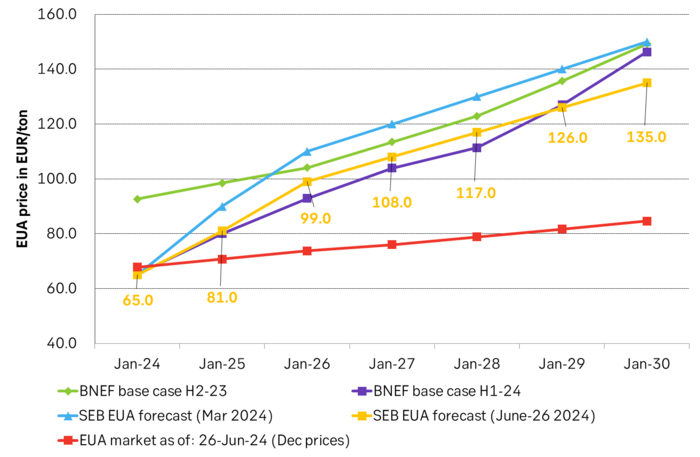
Analys
The most important data point in the global oil market will be published on Friday 28 June


US crude oil production has been booming for more than a decade. Interrupted by two setbacks in response to sharp price declines. The US boom has created large waves in the global oil market and made life very difficult for OPEC(+). Brent crude has not traded below USD 70/b since Dec-2021 and over the past year, it has averaged USD 84/b. US shale oil production would typically boom with such a price level historically. However, there has been zero growth in US crude oil production from Sep-2023 to Mar-2024. This may be partially due to a cold US winter, but something fundamentally seems to have changed. We recently visited a range of US E&P and oil services companies in Houston. The general view was that there would be zero growth in US crude oil production YoY to May 2025. If so and if it also is a general shift to sideways US crude oil production beyond that point, it will be a tremendous shift for the global oil market. It will massively improve the position of OPEC+. It will also sharply change our perception of the forever booming US shale oil supply. But ”the proof is in the pudding” and that is data. More specifically the US monthly, controlled oil production data is to be published on Friday 28 June.
The most important data point in the global oil market will be published on Friday 28 June. The US EIA will then publish its monthly revised and controlled oil production data for April. Following years of booming growth, the US crude oil production has now gone sideways from September 2023 to March 2024. Is this a temporary blip in the growth curve due to a hard and cold US winter or is it the early signs of a huge, fundamental shift where US crude oil production moves from a decade of booming growth to flat-lining horizontal production?
We recently visited a range of E&P and oil services companies in Houston. The general view there was that US crude oil production will be no higher in May 2025 than it is in May 2024. I.e. zero growth.
It may sound undramatic, but if it plays out it is a huge change for the global oil market. It will significantly strengthen the position of OPEC+ and its ability to steer the oil price to a suitable level of its choosing.
The data point on Friday will tell us more about whether the companies we met are correct in their assessment of non-growth in the coming 12 months or whether production growth will accelerate yet again following a slowdown during winter.
The US releases weekly estimates for its crude oil production but these are rough, temporary estimates. The market was fooled by these weekly numbers last year when the weekly numbers pointed to a steady production of around 12.2 m b/d from March to July while actual monthly data, with a substantial lag in publishing, showed that production was rising strongly.
The real data are the monthly, controlled data. These data will be the ”proof of the pudding” of whether US shale oil production now is about to shift from a decade of booming growth to instead flat-line sideways or whether it will drift gradually higher as projected by the US EIA in its latest Short-Term Energy Outlook.
US crude oil production given by weekly data and monthly data. Note that the monthly, controlled data comes with a significant lag. The market was thus navigating along the weekly data which showed ”sideways at 12.2 m b/d” for a significant period last year until actual data showed otherwise with a time-lag.
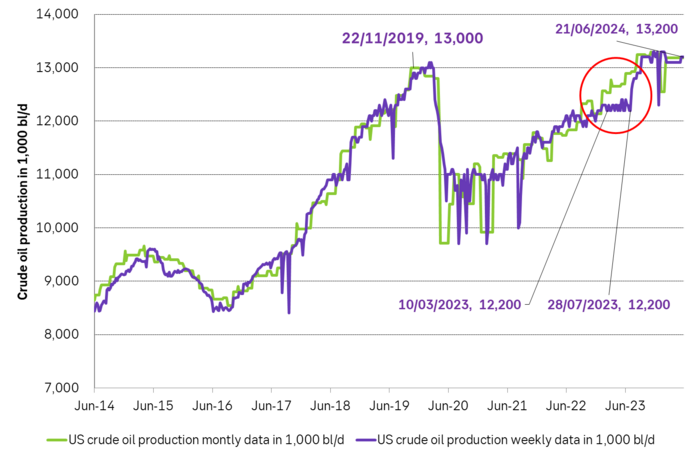
If we add in Natural Gas Liquids and zoom out to include history back to 2001 we see an almost uninterrupted boom in supply since Sep 2011 with a few setbacks. At first glance, this graph gives little support to a belief that US crude oil production now suddenly will go sideways. Simple extrapolation of the graph indicates growth, growth, growth.
US crude and liquids production has boomed since September 2011
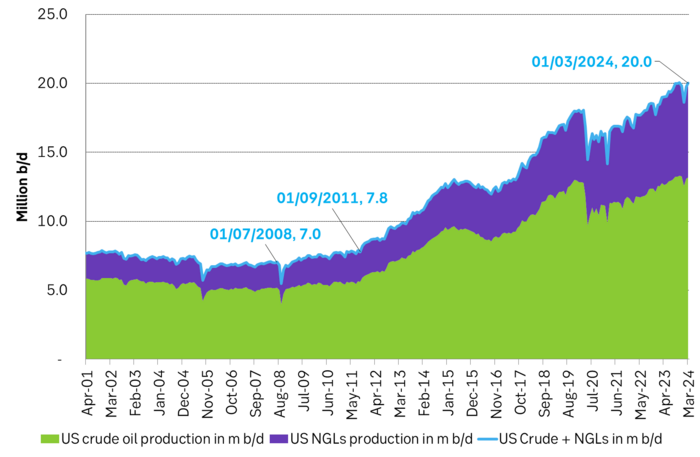
However. The latest actual data point for US crude oil production is for March with a reading of 13.18 m b/d. What stands out is that production then was still below the September level of 13.25 m b/d.
The world has gotten used to forever growing US crude oil production due to the US shale oil revolution, with shorter periods of sharp production declines as a result of sharp price declines.
But the Brent crude oil price hasn’t collapsed. Instead, it is trading solidly in the range of USD 70-80-90/b. The front-month Brent crude oil contract hasn’t closed below USD 70/b since December 2021.
Experiences from the last 15 years would imply wild production growth and activity in US shale oil production at current crude oil prices. But US crude oil production has now basically gone sideways to lower from September to March.
The big, big question is thus: Are we now witnessing the early innings of a big change in US shale oil production where we shift from booming growth to flat-lining of production?
If we zoom in we can see that US liquids production has flat-lined since September 2023. Is the flat-lining from Sep to Mar due to the cold winter so that we’ll see a revival into spring and summer or are we witnessing the early signs of a huge change in the global oil market where US crude oil production goes from booming growth to flat-line production.

The message from Houston was that there will be no growth in US crude oil production until May 2025. SEB recently visited oil and gas producers and services providers in Houston to take the pulse of the oil and gas business. Especially so the US shale oil and shale gas business. What we found was an unusually homogeneous view among the companies we met concerning both the state of the situation and the outlook. The sentiment was kind of peculiar. Everybody was making money and was kind of happy about that, but there was no enthusiasm as the growth and boom years were gone. The unanimous view was that US crude oil production would be no higher one year from now than it is today. I.e. flat-lining from here.
The arguments for flat-lining of US crude oil production here onward were many.
1) The shale oil business has ”grown up” and matured with a focus on profits rather than growth for the sake of growth.
2) Bankruptcies and M&As have consolidated the shale oil companies into larger, fewer public companies now accounting for up to 75% of total production. Investors in these companies have little interest/appetite for growth after having burned their fingers during a decade and a half of capital destruction. These investors may also be skeptical of the longevity of the US shale oil business. Better to fully utilize the current shale oil infrastructure steadily over the coming years and return profits to shareholders than to invest in yet more infrastructure capacity and growth.
3) The remaining 25% of shale oil producers which are in private hands have limited scope for growth as they lack pipeline capacity for bringing more crude oil from field to market. Associated nat gas production is also a problem/bottleneck as flaring is forbidden in many places and pipes to transport nat gas from field to market are limited.
4) The low-hanging fruits of volume productivity have been harvested. Drilling and fracking are now mostly running 24/7 and most new wells today are all ”long wells” of around 3 miles. So hard to shave off yet another day in terms of ”drilling yet faster” and the length of the wells has increasingly reached their natural optimal length.
5) The average ”rock quality” of wells drilled in the US in 2024 will be of slightly lower quality than in 2023 and 2025 will be slightly lower quality than 2024. That is not to say that the US, or more specifically the Permian basin, is quickly running out of shale oil resources. But this will be a slight headwind. There is also an increasing insight into the fact that US shale oil resources are indeed finite and that it is now time to harvest values over the coming 5-10 years. One company we met in Houston argued that US shale oil production would now move sideways for 6-7 years and then overall production decline would set in.
The US shale oil revolution can be divided into three main phases. Each phase is probably equally revolutionary as the other in terms of impact on the global oil market.
1) The boom phase. It started after 2008 but didn’t accelerate in force before the ”Arab Spring” erupted and drove the oil price to USD 110/b from 2011 to 2014. It was talked down time and time again, but it continued to boom and re-boom to the point that today it is almost impossible to envision that it won’t just continue to boom or at least grow forever.
2) The plateau phase. The low-hanging fruits of productivity growth have been harvested. The highest quality resources have been utilized. The halfway point of resources has been extracted. Consolidation, normalization, and maturity of the business has been reached. Production goes sideways.
3) The decline phase. Eventually, the resources will have been extracted to the point that production unavoidably starts to decline.
Moving from phase one to phase two may be almost as shocking for the oil market as the experience of phase 1. The discussions we had with oil producers and services companies in Houston may indicate that we may now be moving from phase one to phase two. That there will be zero shale oil production growth YoY in 2025 and that production then may go sideways for 6-7 years before phase three sets in.
US EIA June STEO report with EIA’s projection for US crude oil production to Dec-2025. Softer growth, but still growth.
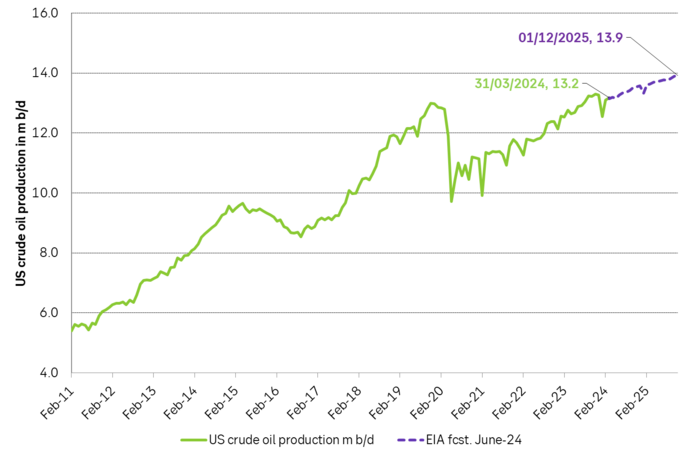
US EIA June STEO report with YoY outlook growth for 2025. Projects that US crude production will grow by 0.47 m b/d YoY in 2025 and that total liquids will grow by 720 k b/d YoY.
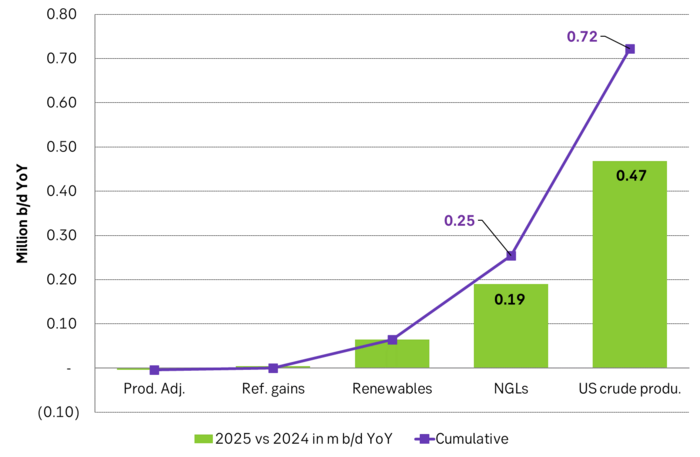
US EIA June STEO report with outlook for production growth by country in 2025. This shows how big the US production growth of 0.7 m b/d YoY really is compared to other producers around the world
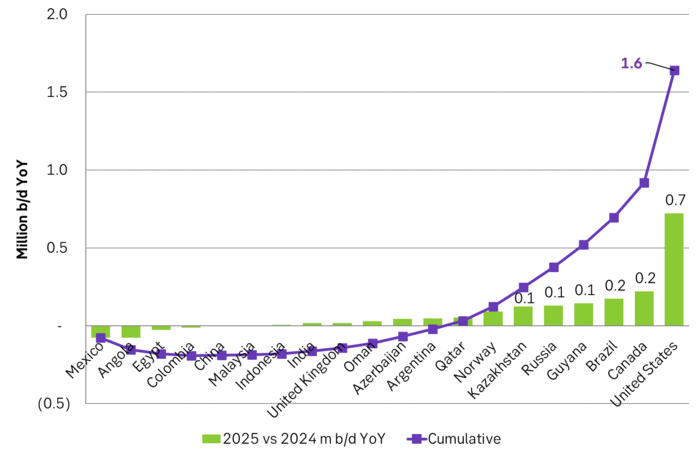
US EIA June STEO report with projected global growth in supply and demand YoY in 2025. Solid demand growth, but even strong supply growth with little room for OPEC+ to expand. Production growth by non-OPEC+ will basically cover global oil demand growth.
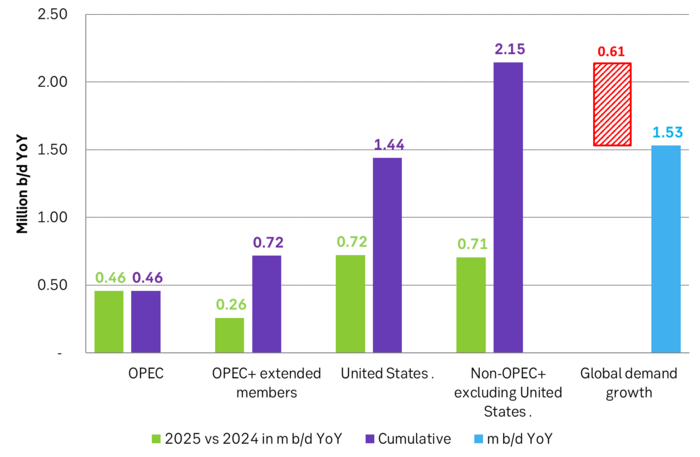
But if there instead is zero growth in US crude oil production in 2025 and the US liquids production only grows by 0.25 m b/d YoY due to NGLs and biofuels, then suddenly there is room for OPEC+ to put some of its current production cuts back into the market. Thus growth/no-growth in US shale oil production will be of huge importance for OPEC+ in 2025. If there is no growth in US shale oil then OPEC+ will have a much better position to control the oil price to where it wants it.
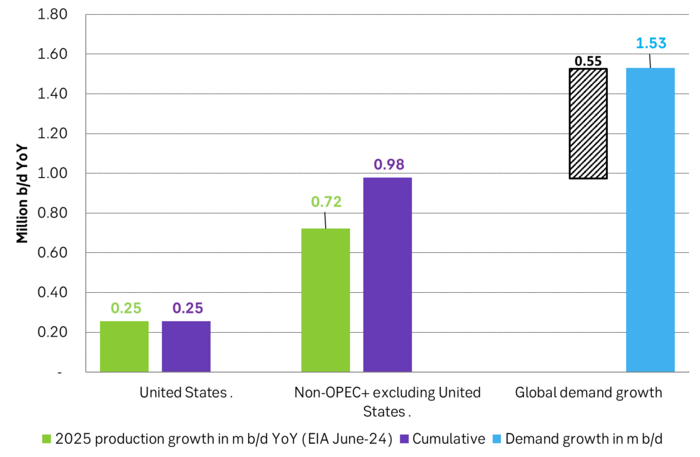
US crude oil production and drilling rig count
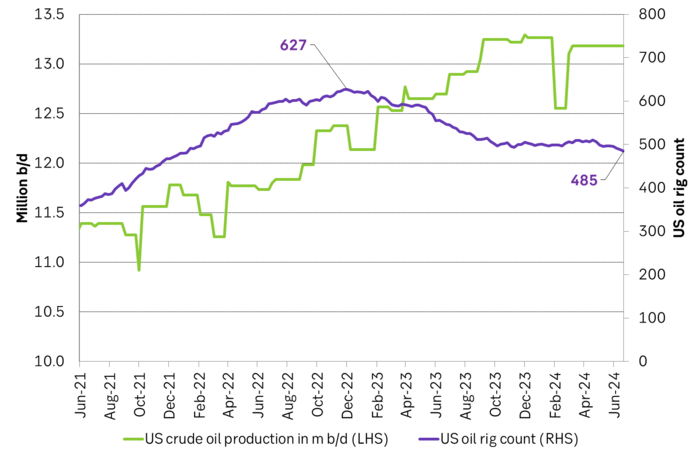
-

 Nyheter1 vecka sedan
Nyheter1 vecka sedanDe tre bästa råvaruvaruaktierna just nu
-

 Nyheter2 veckor sedan
Nyheter2 veckor sedanLundin Mining vill köpa Filo Corp tillsammans med BHP
-

 Nyheter4 veckor sedan
Nyheter4 veckor sedanAfrica Oil är bra att köpa anser Stifel som inleder analysbevakning
-
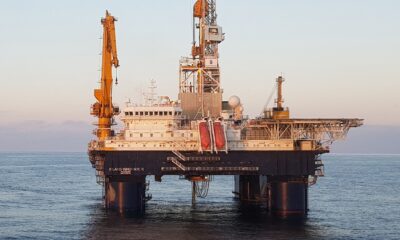
 Nyheter3 veckor sedan
Nyheter3 veckor sedanStor risk att Africa Energy inte överlever det kommande året
-
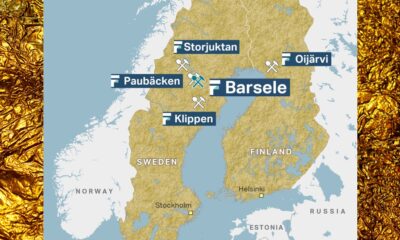
 Nyheter4 veckor sedan
Nyheter4 veckor sedanFirst Nordic Metals har fyra prospekteringsprojekt i Sverige
-

 Analys4 veckor sedan
Analys4 veckor sedanBrent crude inching higher on optimism that US inflationary pressures are fading
-

 Nyheter2 veckor sedan
Nyheter2 veckor sedanUniper satsar på att göra elektrobränsle av sin elektricitet
-

 Nyheter2 veckor sedan
Nyheter2 veckor sedanTre bra aktier inom olja och oljeservice i Kanada


